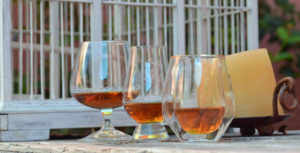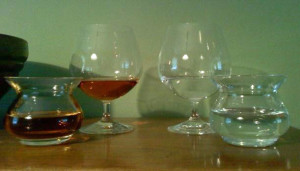By Richard Thomas

(Credit: Richard Thomas)
One of the subjects I see regularly abused by whisk(e)y snobs is glassware. While I encourage enthusiasts to take an interest in things that might enhance their enjoyment of their drink of choice, at the same time I have images of esteemed master distillers drinking their own product out of a Dixie Cup to contrast that to. Memories like that make me look askance at anyone who says something along the lines of “You must drink from this glass, and if your a fool and a poseur if you don’t.”
Certain types of glassware are shaped in a way that aids in the nosing experience. This type of glass is used at any tasting worthy of the name, and as a result any serious enthusiast ought to have glassware of this type on hand, preferably stored on display with his or her collection. That said, nosing glassware is not the end all, be all of drinking whisk(e)y, so don’t feel like you always have to reach for a noser. Snobs are often full of such nonsense, that you must do this or that, and sometimes self-interested nonsense at that. Understanding why something works is better.
The Nosers
Dock Glass
Also known as a Copita, this item looks like a mini-wine glass because it’s the traditional vessel for drinking Sherry. The name “dock glass” comes from its use by merchants who would use the small, easily pocketed vessel for testing wine and spirits at dockside.
Much like a wine glass, the stem is long enough for grasping it instead of the cup, thus keeping any scents on your hand from reaching your nose and preventing your hand from warming the contents. The tulip bulb-shaped bowl (bowls are common to all nosers) concentrates the vapors reaching the nose.
Because dock glasses are relatively inexpensive, they are commonplace at tastings, surpassing even the Glencairn (see below) in ubiquity.
Glencairn
Having been around for a couple of decades, the Glencairn has established itself as the standard nosing glass for anyone in the whisk(e)y trade who wants to take a step up from the dock glass. Relative to the dock glass, the Glencairn presents a narrower bulb shaft and more robust construction, best illustrated by the hefty base. The bottom heavy glass is easier to swish without spilling too.
Glencairns are reasonably priced, but as the proprietary design of Glencairn Whisky Glass, it isn’t quite as cheap as the dock glass, which can be made by anyone. However, it is inexpensive enough that many bars, distilleries, and tasting hosts use the Glencairn (this despite the breakage). For those who want something extra, cut crystal and personalized Glencairns are available.
NEAT Glass
The NEAT glass uses an exaggerated bulb design with a wider, almost spherical bottom topped by a waspy waist that rises to a wider rim. This combination is supposed to maximize evaporation while dissipating harsh alcohol vapors, leaving just what you want to nose hovering in the center of the glass’s mouth. Opinions on the effectiveness of the NEAT Glass are divided; some swear by it while others report modest or no improvement over the Glencairn.

(Credit: S.D. Peters)
Norlan Glass
Whereas the NEAT glass innovated on the Glencairn by enhancing its nosing characteristics, the Norlan improves on it by combining the basic characteristics of the Glencairn shape with the functionality of the tumbler. The result is a glass just as good as a Glencairn for nosing, but as handy as a tumbler for holding. It is also one of the coolest-looking whisk(e)y glasses around.
Snifter
The snifter gets a bad rap among many in whisk(e)y circles, and for little objective cause. Most of it boils down to the fact that, as whisk(e)y glasses go, the snifter is even more humble than the dock glass, the thing your granddaddy used.
As a noser for whisk(e)y, the snifter does have the drawback of taking an utterly out-sized bowl (even more so than in the NEAT glass) and combining it with a narrow opening. This is supposed to concentrate the harsh alcohol vapors to the point of overpowering the senses. In my experiences, that is never true of spirits at the 80 proof/40% ABV level, but stronger the spirit the more likely it is to be so. This makes the snifter a bad choice for nosing cask strength.
If this mark against the snifter is half-true, another complaint about the snifter is pure balderdash. While it is true the snifter was designed with brandy in mind, and the big bowl intended to be grasped so the hand warms the liquid, there is no reason why this should ruin whisk(e)y. The Glencairn must be grasped too (albeit not by the whole hand), and the snifter has a small stem that can be held instead. I have done exactly that—grasped the snifter by the stem—for years.
Finally, one helpful aspect of the snifter’s design is that you can tip it over about halfway and it won’t spill its contents. That is not a bad feature for imbibing at parties.
The Not-Nosers
Highball Glass
A tall, narrow cylinder, the highball glass enters crossed into whisk(e)y territory as the favored vessel for Scotch and soda. With that in mind, it’s a logical vessel for Bourbon/Jack and Coke or ginger ale, or any other simple mixer that comes to mind.
Tumbler
This one is sometimes called a “rocks glass,” because it’s the one you drink your whiskey on the rocks in.In my experience, it is by far the most common vessel to see whisk(e)y served in, because it is so favored at your average bar. It’s also the choice for a variety of cocktails, such as the Old Fashioned. If you want whisk(e)y with ice, you absolutely want a tumbler, and it is a fine choice if you want to sip your whisk(e)y without nosing it much.




Glad to see this subject getting some attention here. I’d like to add two of my favorites to the lineup. I much prefer the elegance of the Glencairn Wide Bowl to the clunky style of the NEAT glass. Personally, I find the NEAT to be embarrassingly ugly.
As I’m primarily focused on American whiskey, I find that they do not necessarily need the aroma “concentrating” feature of many nosing glasses, as they already pack enough punch to get through regardless of vessel style. Hence, my second addition, what I’ll call the Western-style rocks glass, epitomized by the Libbey Gibraltar. Heavy and substantial, it looks like it would be at home on the bar in any cowboy movie you’ve ever seen. Bourbon and rye are right in their wheelhouse here.
Keep up the great work…this blog is an oasis compared to the ever-decreasing postings elsewhere!
Thanks!
Nice review! Another entry into the Dock glass category is the humble INAO wine tasting glass.
I used to use Reidel scotch glasses but have switched to the Glencairn glass. I find it works best for just about any hard alcohol you want to nose. And I don’t cry when I break one.
In the tumbler category, I really like the mini tumblers. They work very well for drinking it best or with an ice cube.
“Drinking it neat”. I hate auto correct.